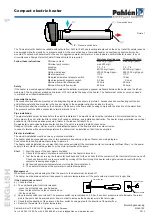
11
Water Supply Connections
IMPORTANT: Do not
apply heat to the HOT or
COLD water connections. If
sweat connections are used,
sweat tubing to adapter
before fitting adapter to
the water connections on
heater. Any heat applied
to the water supply fittings
will permanently damage
the internal components
of the water heater.
Mounting the Water Heater
Make sure the location of the appliance allows
for easy access and operation .
Wall studs should be utilized when mounting
the water heater to the wall . Alternately, a
suitable piece of wood may be placed inside
or outside of the wall to span the distance
between the wall studs . Fasten the water
heater mounting brackets to the wood .
In case of dry wall or concrete wall, use
drywall anchors or lag bolts .
The water heater requires 120vAC/60Hz .
Have a receptacle with ground terminal near
the water heater . A power supply cord is not
supplied with the water heater . Install a wood
screw for the upper bracket with a clearance
of 1/8” ( .32 cm) between the wall and the
screw head . Hang the center of the upper
bracket on the screw .
Using a wood screw and a washer, affix the
lower bracket to the wall (Left and Right) .
Repeat to affix the top bracket .
Upper Bracket
Washer
Washer
Wood
Screw
Wood
Screw
Wood
Screw
Lower Bracket
1/8" (.32 cm)
Clearance
Plumbing should be carried out by a qualified
plumber in accordance with local codes .
Use approved plumbing materials only .
The diameter of the pipe lines should be a
minimum of 3/4” .
To conserve energy and to prevent freezing,
insulate both cold and hot water supply
lines . DO NOT cover the drain or pressure
relief valve .
To ensure proper operation of the water
heater, the following water pressure guidelines
should be followed:
●
Operation of the water heater requires the
minimum water pressure of 14 psi (97 kPa)
and a minimum water flow rate of 0 .66
gpm (2 .5 lpm) .
●
A water pressure of 40 psi (276 kPa) is
required to achieve maximum flow rate .
●
To maintain proper performance, ensure
sufficient water supply pressure . The
Required Water Pressure = Min . Operating
Water Pressure (14 psi [97 kPa]) + Pipe
Pressure Loss + Faucet and Shower
Pressure Loss + Safety Margin (more than
5 psi [34 kPa]) .
●
To supply hot water to upper floors,
additional water pressure (0 .44 psi/ft
[10 kPa/m]) must be ensured . The
measurement should be calculated by the
distance between the water inlet of the
water heater (ground level) to the hot
water faucet (upper floor level) .
●
Well water systems should be set to ensure
a minimum system pressure of 40 psi (276
kPa) . The pressure should remain stable
during the operation of the water heater .
●
When the water is supplied from a water
supply tank, the height of the tank and the
diameter of the pipes and their relation
to water pressure should be taken into
consideration .
Gravity water pressure is
not recommended
.
CAUTION:
Reinforcement of the wall is
required in case the wall is
not strong enough to hold
the appliance.
Installing the water heater:
Thermal Expansion
A thermal expansion tank will be required if
the water heater is installed in a closed loop
system to prevent damage to heater, related
piping and relief valve . Replacing the relief
valve will not correct the problem! The
expansion tank is designed with an air cushion
built in that compresses as the system pressure
increases, thereby relieving the over pressure
condition and eliminating the repeated
operation of the relief valve . Other methods
of controlling thermal expansion are also
available . Contact your installing contractor,
water supplier or plumbing inspector for
additional information regarding this subject .
Notice: Due to cold
environments, ice may
potentially accumulate at
the water connections. In
this case, please insert the
power cord of the water
heater into an electrical
outlet. The ice should melt
within approximately 10
minutes and at this time the
water connections can be
made.












































